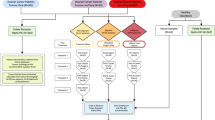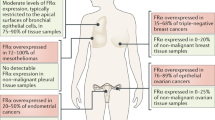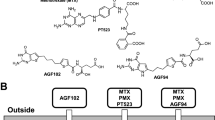Abstract
Folate can be transported into the cell by the reduced folate carrier (RFC), the proton-coupled folate transporter (PCFT), or the folate receptor (FR), of which various isoforms exist. While the RFC and PCFT are expressed by many normal cells, the FR is present only in a small proportion of normal tissues. In these tissues, the FR expression level is often low and restricted to the apical surface of polarized epithelial cells. In contrast, FR is expressed on the blood-accessible basal and lateral membranes of many types of epithelial cancer. Considering that FR is expressed in few nonmalignant cell types on luminal membranes generally not accessible for molecules transported in the blood, FR is considered a promising antitumor target. As FR expression seems associated with tumor progression and prognosis, anticancer therapies targeting FR are currently being developed, such as farletuzumab (Morphotek, Exton, PA, USA), IMGN853 (ImmunoGen, Waltham, MA, USA), vintafolide, and EC1456 (both Endocyte Inc., West Lafayette, IN, USA). FR expression could be used as a response-predictive biomarker for these treatments. The ability to identify patients and treat them with an effective therapy based on the known expression of the tumor marker would, indeed, be the next step in predictive medicine for these patients. This review summarizes the role of FR in ovarian cancer and the value of FR as a prognostic biomarker for ovarian cancer and a response-predictive biomarker for folate-targeted therapeutics.



Similar content being viewed by others
References
Tibbetts, A. S., & Appling, D. R. (2010). Compartmentalization of mammalian folate-mediated one-carbon metabolism. Annual Review of Nutrition, 3, 57–81.
Choi, S. W., & Mason, J. B. (2000). Folate and carcinogenesis: an integrated scheme. The Journal of Nutrition, 130(2), 129–132.
Stover, P. J. (2004). Physiology of folate and vitamin B12 in health and disease. Nutrition Reviews, 62(6 Pt 2), S3–S12. discussion S13.
Wani, N. A., Hamid, A., & Kaur, J. (2008). Folate status in various pathophysiological conditions. IUBMB Life, 60(12), 834–842.
Zhao, R., Diop-Bove, N., Visentin, M., & Goldman, I. D. (2011). Mechanisms of membrane transport of folates into cells and across epithelia. Annual Review of Nutrition, 31, 177–201.
Matherly, L. H., Hou, Z., & Deng, Y. (2007). Human reduced folate carrier: translation of basic biology to cancer etiology and therapy. Cancer Metastasis Reviews, 26(1), 111–128.
Kelemen, L. E. (2006). The role of folate receptor alpha in cancer development, progression and treatment: cause, consequence or innocent bystander? International Journal of Cancer, 119(2), 243–250.
Matherly, L. H., & Goldman, D. I. (2003). Membrane transport of folates. Vitamins and Hormones, 66, 403–456.
Zhao, R., & Goldman, I. D. (2007). The molecular identity and characterization of a Proton-coupled Folate Transporter–PCFT; biological ramifications and impact on the activity of pemetrexed. Cancer Metastasis Reviews, 26(1), 129–139.
Salazar, M. D., & Ratnam, M. (2007). The folate receptor: what does it promise in tissue-targeted therapeutics? Cancer Metastasis Reviews, 26(1), 141–152.
Ross, J. F., Chaudhuri, P. K., & Ratnam, M. (1994). Differential regulation of folate receptor isoforms in normal and malignant tissues in vivo and in established cell lines. Physiologic and clinical implications. Cancer, 73(9), 2432–2443.
Xia, W., Hilgenbrink, A. R., Matteson, E. L., Lockwood, M. B., Cheng, J. X., & Low, P. S. (2009). A functional folate receptor is induced during macrophage activation and can be used to target drugs to activated macrophages. Blood, 113(2), 438–446.
Yamaguchi, T., Hirota, K., Nagahama, K., Ohkawa, K., Takahashi, T., Nomura, T., et al. (2007). Control of immune responses by antigen-specific regulatory T cells expressing the folate receptor. Immunity, 27(1), 145–159.
Kinoshita, M., Kayama, H., Kusu, T., Yamaguchi, T., Kunisawa, J., Kiyono, H., et al. (2012). Dietary folic acid promotes survival of Foxp3+ regulatory T cells in the colon. Journal of Immunology, 189(6), 2869–2878.
Shen, F., Ross, J. F., Wang, X., & Ratnam, M. (1994). Identification of a novel folate receptor, a truncated receptor, and receptor type beta in hematopoietic cells: cDNA cloning, expression, immunoreactivity, and tissue specificity. Biochemistry, 33(5), 1209–1215.
Parker, N., Turk, M. J., Westrick, E., Lewis, J. D., Low, P. S., & Leamon, C. P. (2005). Folate receptor expression in carcinomas and normal tissues determined by a quantitative radioligand binding assay. Analytical Biochemistry, 338(2), 284–293.
Smith, S. B., Kekuda, R., Gu, X., Chancy, C., Conway, S. J., & Ganapathy, V. (1999). Expression of folate receptor alpha in the mammalian retinol pigmented epithelium and retina. Investigative Ophthalmology & Visual Science, 40(5), 840–848.
Solanky, N., Requena, J. A., D’Souza, S. W., Sibley, C. P., & Glazier, J. D. (2010). Expression of folate transporters in human placenta and implications for homocysteine metabolism. Placenta, 31(2), 134–143.
Kamen, B. A., & Smith, A. K. (2004). A review of folate receptor alpha cycling and 5-methyltetrahydrofolate accumulation with an emphasis on cell models in vitro. Advanced Drug Delivery Reviews, 256(8), 1085–1097.
Selhub, J., Emmanouel, D., Stavropoulos, T., & Arnold, R. (1987). Renal folate absorption and the kidney folate binding protein. I. Urinary clearance studies. The American Journal of Physiology, 252(4 Pt 2), F750–F756.
Smith, A. D., Kim, Y. I., & Refsum, H. (2008). Is folic acid good for everyone? The American Journal of Clinical Nutrition, 87(3), 517–533.
Siu, M. K., Kong, D. S., Chan, H. Y., Wong, E. S., Ip, P. P., Jiang, L., et al. (2012). Paradoxical impact of two folate receptors, FRα and RFC, in ovarian cancer: effect on cell proliferation, invasion and clinical outcome. PLoS One, 7(11), e47201.
Kim, Y. I. (2003). Role of folate in colon cancer development and progression. The Journal of Nutrition, 133(11 Suppl 1), 3731S–3739S.
Crider, K. S., Yang, T. P., Berry, R. J., & Bailey, L. B. (2012). Folate and DNA methylation: a review of molecular mechanisms and the evidence for folate’s role. Advances in Nutrition (Bethesda, Md.), 3(1), 21–38.
Larsson, S. C., Giovannucci, E., & Wolk, A. (2004). Dietary folate intake and incidence of ovarian cancer: the Swedish Mammography Cohort. Journal of the National Cancer Institute, 96(5), 396–402.
Giovannucci, E. (2002). Epidemiologic studies of folate and colorectal neoplasia: a review. The Journal of Nutrition, 132(8 Suppl), 2350S–2355S.
Zhang, C. X., Ho, S. C., Chen, Y. M., Lin, F. Y., Fu, J. H., & Cheng, S. Z. (2011). Dietary folate, vitamin B6, vitamin B12 and methionine intake and the risk of breast cancer by oestrogen and progesterone receptor status. British Journal of Nutrition, 106(6), 936–943.
Tavani, A., Malerba, S., Pelucchi, C., Dal, M. L., Zucchetto, A., Serraino, D., et al. (2012). Dietary folates and cancer risk in a network of case–control studies. Annals of Oncology, 23(10), 2737–2742.
Stolzenberg-Solomon, R. Z., Chang, S. C., Leitzmann, M. F., Johnson, K. A., Johnson, C., Buys, S. S., et al. (2006). Folate intake, alcohol use, and postmenopausal breast cancer risk in the prostate, lung, colorectal, and ovarian cancer screening trial. The American Journal of Clinical Nutrition, 83(4), 895–904.
Kim, Y. I. (2007). Folate and colorectal cancer: an evidence-based critical review. Molecular Nutrition & Food Research, 51(3), 267–292.
Hultdin, J., Van Guelpen, B., Bergh, A., Hallmans, G., & Stattin, P. (2005). Plasma folate, vitamin B12, and homocysteine and prostate cancer risk: a prospective study. International Journal of Cancer, 113(5), 819–824.
Zhang Z., Wang J., Tacha D. E., Li P., Bremer R. E., Chen H., et al. (2014). Folate receptor α associated with triple-negative breast cancer and poor prognosis. Archives of Pathology & Laboratory Medicine, 138(7):890–895.
Matulonis, U. A., Horowitz, N. S., Campos, S. M., Lee, H., Lee, J., Krasner, C. N., et al. (2008). Phase II study of carboplatin and pemetrexed for the treatment of platinum-sensitive recurrent ovarian cancer. Journal of Clinical Oncology, 26(35), 5761–5766.
Vergote, I., Calvert, H., Kania, M., Kaiser, C., Zimmermann, A. H., & Sehouli, J. (2009). A randomised, double-blind, phase II study of two doses of pemetrexed in the treatment of platinum-resistant, epithelial ovarian or primary peritoneal cancer. European Journal of Cancer, 45(8), 1415–1423.
Kurkjian C., LoRusso P., Sankhala K. K., Birrer M. J., Kirby M., Ladd S., et al. (2013). A phase 1, first-in-human study to evaluate the safety, pharmacokinetics (PK), and pharmacodynamics (PD) of IMGN853 in patients (Pts) with epithelial ovarian cancer (EOC) and other FOLR1-positive solid tumors. ASCO Meeting Abstracts, 31(15_suppl), 2573.
Ma, D. W., Finnell, R. H., Davidson, L. A., Callaway, E. S., Spiegelstein, O., Piedrahita, J. A., et al. (2005). Folate transport gene inactivation in mice increases sensitivity to colon carcinogenesis. Cancer Research, 65(3), 887–897.
Desmoulin, S. K., Hou, Z., Gangjee, A., & Matherly, L. H. (2012). The human proton-coupled folate transporter: biology and therapeutic applications to cancer. Cancer Biology & Therapy, 13(14), 1355–1373.
Siegel, R., Naishadham, D., & Jemal, A. (2013). Cancer statistics, 2013. CA: A Cancer Journal for Clinicians, 63(1), 11–30.
Kalli, K. R., Oberg, A. L., Keeney, G. L., Christianson, T. J., Low, P. S., Knutson, K. L., et al. (2008). Folate receptor alpha as a tumor target in epithelial ovarian cancer. Gynecologic Oncology, 108(3), 619–626.
Bagnoli, M., Canevari, S., Figini, M., Mezzanzanica, D., Raspagliesi, F., Tomassetti, A., et al. (2003). A step further in understanding the biology of the folate receptor in ovarian carcinoma. Gynecologic Oncology, 88(1 Pt 2), S140–S144.
Despierre, E., Lambrechts, S., Leunen, K., Berteloot, P., Neven, P., Amant, F., et al. (2013). Folate receptor alpha (FRA) expression remains unchanged in epithelial ovarian and endometrial cancer after chemotherapy. Gynecolic Oncology, 130(1), 192–199.
Kelley, K. M., Rowan, B. G., & Ratnam, M. (2003). Modulation of the folate receptor alpha gene by the estrogen receptor: mechanism and implications in tumor targeting. Cancer Research, 63(11), 2820–2828.
Sivakumaran, S., Zhang, J., Kelley, K. M., Gonit, M., Hao, H., & Ratnam, M. (2010). Androgen activation of the folate receptor α gene through partial tethering of the androgen receptor by C/EBPα. The Journal of Steroid Biochemistry and Molecular Biology, 122(5), 333–340.
Shatnawi, A., Tran, T., & Ratnam, M. (2007). R5020 and RU486 act as progesterone receptor agonists to enhance Sp1/Sp4-dependent gene transcription by an indirect mechanism. Molecular Endocrinology (Baltimore, Md.), 21(3), 635–650.
Tran, T., Shatnawi, A., Zheng, X., Kelley, K. M., & Ratnam, M. (2005). Enhancement of folate receptor alpha expression in tumor cells through the glucocorticoid receptor: a promising means to improved tumor detection and targeting. Cancer Research, 65(10), 4431–4441.
Doucette, M. M., & Stevens, V. L. (2001). Folate receptor function is regulated in response to different cellular growth rates in cultured mammalian cells. The Journal of Nutrition, 131(11), 2819–2825.
Toffoli, G., Cernigoi, C., Russo, A., Gallo, A., Bagnoli, M., & Boiocchi, M. (1997). Overexpression of folate binding protein in ovarian cancers. International Journal of Cancer, 174(2), 193–198.
Chen, Y. L., Chang, M. C., Huang, C. Y., Chiang, Y. C., Lin, H. W., Chen, C. A., et al. (2012). Serous ovarian carcinoma patients with high alpha-folate receptor had reducing survival and cytotoxic chemo-response. Molecular Oncology, 6(3), 360–369.
O’Shannessy, D. J., Somers, E. B., Smale, R., & Fu, Y. S. (2013). Expression of folate receptor-α (FRA) in gynecologic malignancies and its relationship to the tumor type. International Journal of Gynecological Pathology, 32(3), 258–268.
Despierre, E., Lambrechts, S., Leunen, K., Neven, P., Amant, F., O’Shannessy, D. J., et al. (2012). Folate receptor alpha: potential therapeutic target for pure yolk sac tumors and mixed germ cell tumors with yolk sac component. International Journal of Gynecological Cancer, 22(8 suppl 3).
Toffoli, G., Russo, A., Gallo, A., Cernigoi, C., Miotti, S., Sorio, R., et al. (1998). Expression of folate binding protein as a prognostic factor for response to platinum-containing chemotherapy and survival in human ovarian cancer. International Journal of Cancer, 179(2), 121–126.
Naumann, R. W., Coleman, R. L., Burger, R. A., Sausville, E. A., Kutarska, E., Ghamande, S. A., et al. (2013). PRECEDENT: a randomized phase II trial comparing vintafolide (EC145) and pegylated liposomal doxorubicin (PLD) in combination versus PLD alone in patients with platinum-resistant ovarian cancer. Journal of Clinical Oncology, 31(35), 4400–4406.
Cerezo, A., Guadamillas, M. C., Goetz, J. G., Sánchez-Perales, S., Klein, E., Assoian, R. K., et al. (2009). The absence of caveolin-1 increases proliferation and anchorage- independent growth by a Rac-dependent, Erk-independent mechanism. Molecular Cell Biology, 29(18), 5046–5059.
Kannan, A., Krishnan, A., Ali, M., Subramaniam, S., Halagowder, D., & Sivasithamparam, N. D. (2014). Caveolin-1 promotes gastric cancer progression by up-regulating epithelial to mesenchymal transition by crosstalk of signalling mechanisms under hypoxic condition. European Journal of Cancer, 50(1), 204–215.
Yilmaz, M., & Christofori, G. (2010). Mechanisms of motility in metastasizing cells. Molecular Cancer Research: MCR, 8(5), 629–642.
Leamon, C. P., Parker, M. A., Vlahov, I. R., Xu, L. C., Reddy, J. A., Vetzel, M., et al. (2002). Synthesis and biological evaluation of EC20: a new folate-derived, (99m)Tc-based radiopharmaceutical. Bioconjugate Chemistry, 13(6), 1200–1210.
Teng, L., Xie, J., Teng, L., & Lee, R. J. (2012). Clinical translation of folate receptor-targeted therapeutics. Expert Opinion on Drug Delivery, 9(8), 901–908.
Konner, J. A., Bell-McGuinn, K. M., Sabbatini, P., Hensley, M. L., Tew, W. P., Pandit-Taskar, N., et al. (2010). Farletuzumab, a humanized monoclonal antibody against folate receptor alpha, in epithelial ovarian cancer: a phase I study. Clinical Cancer Research, 16(21), 5288–5295.
Armstrong, D. K., White, A. J., Weil, S. C., Phillips, M., & Coleman, R. L. (2013). Farletuzumab (a monoclonal antibody against folate receptor alpha) in relapsed platinum-sensitive ovarian cancer. Gynecologic Oncology, 129(3), 452–458.
Vergote I., Armstrong D., Scambia G., Fujiwara K., Gorbunova V., Schweizer C., et al. (2013). Phase 3 double-blind, placebo-controlled study of weekly farletuzumab with carboplatin/taxane in subjects with platinum-sensitive ovarian cancer in first relapse. International Journal of Gynecological Cancer, 23(8); Supplement 1.
Walters, C. L., Arend, R. C., Armstrong, D. K., Naumann, R. W., & Alvarez, R. D. (2013). Folate and folate receptor alpha antagonists mechanism of action in ovarian cancer. Gynecologic Oncology, 131(2), 493–498.
Lorusso, P. M., Edelman, M. J., Bever, S. L., Forman, K. M., Pilat, M., Quinn, M. F., et al. (2012). Phase I study of folate conjugate EC145 (Vintafolide) in patients with refractory solid tumors. Journal of Clinical Oncology, 30(32), 4011–4016.
Morris, R. T., Joyrich, R. N., Naumann, R. W., Shah, N. P., Maurer, A. H., Strauss, H. W., et al. (2014). Phase 2 study of treatment of advanced ovarian cancer with folate-receptor-targeted therapeutic (vintafolide) and companion SPECT-based imaging agent (99mTc-etarfolatide). Annals of Oncology, 25(4), 852–858.
Ebel, W., Routhier, E. L., Foley, B., Jacob, S., McDonough, J. W., Patel, R. K., et al. (2007). Preclinical evaluation of MORAb-003, a humanized monoclonal antibody antagonizing folate receptor-alpha. Cancer Immunity, 7, 6.
Lin, J., Spidel, J. L., Maddage, C. J., Rybinski, K. A., Kennedy, R. P., Krauthauser, C. L., et al. (2013). The antitumor activity of the human FOLR1-specific monoclonal antibody, farletuzumab, in an ovarian cancer mouse model is mediated by antibody-dependent cellular cytotoxicity. Cancer Biology & Therapy, 14(11), 1032–1038.
Vlahov, I. R., Santhapuram, H. K., Kleindl, P. J., Howard, S. J., Stanford, K. M., & Leamon, C. P. (2013). Design and regioselective synthesis of a new generation of targeted chemotherapeutics. Part 1: EC145, a folic acid conjugate of desacetylvinblastine monohydrazide. Bioorganic & Medicinal Chemistry Letters, 16(19), 5093–5096.
Reddy, J. A., Dorton, R., Westrick, E., Dawson, A., Smith, T., Xu, L. C., et al. (2007). Preclinical evaluation of EC145, a folate-vinca alkaloid conjugate. Cancer Research, 67(9), 4434–4442.
Reddy J. A., Dorton R., Dawson A., Nelson M., Vetzel M., Guan J, et al. (2014). Rational combination therapy of vintafolide (EC145) with commonly used chemotherapeutic drugs.@@ Clinical Cancer Research, Epub ahead of print.
Chen, H., Zhang, T., Zhou, Z., Guan, M., Wang, J., Liu, L., et al. (2013). Enhanced uptake and cytotoxicity of folate-conjugated mitoxantrone-loaded micelles via receptor up-regulation by dexamethasone. International Journal of Pharmaceutics, 448(1), 142–149.
Sega, E. I., & Low, P. S. (2008). Tumor detection using folate receptor-targeted imaging agents. Cancer Metastasis Reviews, 27(4), 655–664.
Mantovani, L. T., Miotti, S., Ménard, S., Canevari, S., Raspagliesi, F., Bottini, C., et al. (1994). Folate binding protein distribution in normal tissues and biological fluids from ovarian carcinoma patients as detected by the monoclonal antibodies MOv18 and MOv19. European Journal of Cancer, 30A(3), 363–369.
Fisher, R. E., Siegel, B. A., Edell, S. L., Oyesiku, N. M., Morgenstern, D. E., Messmann, R. A., et al. (2008). Exploratory study of 99mTc-EC20 imaging for identifying patients with folate receptor-positive solid tumors. Journal of Nuclear Medicine, 49(6), 899–906.
Maurer A. H., Elsinga P., Fanti S., Nguyen B., Oyen W. J., Weber W. A. Imaging the folate receptor on cancer cells with 99mTc-etarfolatide—properties, clinical use, and future potential of folate receptor imaging. Journal of Nuclear Medicine, accepted for publication.
Elnakat, H., & Ratnam, M. (2004). Distribution, functionality and gene regulation of folate receptor isoforms: implications in targeted therapy. Advanced Drug Delivery Reviews, 56(8), 1067–1084.
Reddy, J. A., Allagadda, V. M., & Leamon, C. P. (2005). Targeting therapeutic and imaging agents to folate receptor positive tumors. Current Pharmaceutical Biotechnology, 6(2), 131–150.
Acknowledgments
Editorial and medical writing assistance was provided by Anna Hooijkaas, PhD, TRM Oncology, The Hague, The Netherlands, funded by Endocyte Inc., West Lafayette, IN, USA. The authors are fully responsible for content and editorial decisions for this manuscript.
Conflict of interest
IV received honoraria for advisory boards for Endocyte and Merck. CM received honoraria for advisory boards for Endocyte and Merck. RC served on steering committees for Merck, Endocyte, and Morphotek/Eisai and received research funding from Merck.
Author information
Authors and Affiliations
Corresponding author
Rights and permissions
About this article
Cite this article
Vergote, I.B., Marth, C. & Coleman, R.L. Role of the folate receptor in ovarian cancer treatment: evidence, mechanism, and clinical implications. Cancer Metastasis Rev 34, 41–52 (2015). https://doi.org/10.1007/s10555-014-9539-8
Published:
Issue Date:
DOI: https://doi.org/10.1007/s10555-014-9539-8




